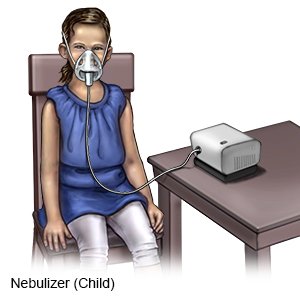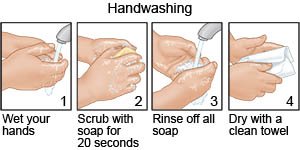Nebulizer Use for Children
Medically reviewed by Drugs.com. Last updated on Apr 6, 2025.
What is a nebulizer?
A nebulizer is a device that turns liquid medicine into a mist. The nebulizer is usually connected to a machine that pushes air through the nebulizer. The air helps turn the medicine into a mist. As your child breathes, the mist of medicine goes into his or her lungs. When a nebulizer is used, it is called a breathing treatment or nebulizer treatment.
 |
Why does my child need breathing treatments?
Breathing treatments are used to treat the swelling in your child's airway, shortness of breath, coughing, and wheezing. These can be caused by any of the following:
- Chronic respiratory diseases, such as asthma and cystic fibrosis
- Lung infections, such as pneumonia
- Severe allergic reactions
How might my child receive a breathing treatment?
The way your child receives nebulized medicine depends on his or her age and coordination. A breathing treatment may be given in any of the following ways:
- A face mask may be used for children of all ages. It should cover your child's nose and mouth completely. The face mask should fit snugly against your child's face.
- A mouthpiece may be used by children older than 4 years old. Your child places the mouthpiece tightly between his or her lips.
How do I prepare the nebulizer for my child's breathing treatment?
Read and follow the instructions that come with your child's nebulizer. The following is general information:
- Wash your hands with soap and water. Always wash your hands, or have your child wash his or her hands, before preparing the nebulizer for use. This helps prevent germs from getting into your child's lungs.

- Prepare the machine. Place the machine on a hard surface. Check to see if the air filter is clean. If it is dirty, rinse it with cold water and let it air dry. Plug in the machine.
- Prepare the medicine. If your child's medicine is premixed, open it and place it in the nebulizer medicine container. If you have to mix medicines, place the correct amounts into the container using a dropper or syringe.
- Add saline if needed. You may need to add saline (saltwater) to your child's medicine container. Buy sterile normal saline at a pharmacy. Do not use homemade saline solution in a nebulizer.
- Connect the container. Connect the medicine container to the machine using the tubing. Connect the mask or mouthpiece to the top of the container.
Drugs used to treat this and similar conditions
Paracetamol
Paracetamol (Panadol, Calpol, Alvedon) is a widely used over-the-counter painkiller and fever ...
Zyrtec
Zyrtec (cetirizine) is used to treat allergy symptoms such as sneezing, itching, watery eyes, or ...
Omvoh
Omvoh is used to treat moderate to severe ulcerative colitis or Crohn's disease in adults. This ...
Flonase
Flonase (fluticasone nasal) is used to treat nasal congestion, sneezing, and runny nose caused by ...
Azithromycin Dose Pack
Azithromycin Dose Pack is used for babesiosis, bacterial endocarditis prevention, bacterial ...
Tylenol
Tylenol is a pain reliever and a fever reducer used to treat many conditions such as headaches ...
Loratadine
Loratadine is a non-drowsy antihistamine used to relieve allergy symptoms like sneezing, runny ...
Amoxicillin
Amoxicillin is a penicillin antibiotic that fights bacteria. It is used to treat many types of ...
Prednisone
Prednisone is used to treat allergic disorders, ulcerative colitis, psoriasis and arthritis. Learn ...
Fluticasone nasal
Fluticasone nasal is used for allergic rhinitis, allergies, chronic rhinosinusitis with nasal ...
How should I give my child a breathing treatment?
- Place the mask on your child's face. You may need to distract an infant or younger child during the treatment. Distraction, such as a movie or favorite toy, may help to keep him or her from removing the mask.
- Have your child place the mouthpiece in his or her mouth. Make sure the mouthpiece is between your child's teeth and his or her lips are closed around it. Your child should breathe in and out slowly through his or her mouth until all the medicine is gone.
- Turn on the machine. Keep the medicine container in an upright position. The whole treatment may take up to 15 minutes. The treatment is over when all the medicine is gone or no more mist is coming out. The machine may also make a sputtering noise when treatment is done.
- Rinse your child's mouth with water or saline after each treatment. Make sure your child does not swallow the water or saline. If your child uses a mask, wash his or her face after each treatment.
How do I take care of my child's nebulizer?
- Clean your child's nebulizer after each use. Separate all pieces before cleaning. Do not clean the pieces in a sink. Use a dedicated clean bowl. Wash the container and mouthpiece or mask with dish soap and warm water. Shake off the extra water and let the parts air dry. Make sure all pieces are completely dry before storing them away.
- Disinfect your child's nebulizer as directed. Follow the disinfection instructions that come with your child's nebulizer.
Call your local emergency number (911 in the US) if:
- Your child's breathing gets worse after a treatment.
- Your child coughs up blood.
- Your child complains of chest tightness.
When should I seek immediate care?
- Your child develops a rash or hives after a treatment.
When should I call my child's doctor?
- Your child has trouble completing treatments.
- Your child's symptoms are not completely relieved after a treatment.
- Your child has problems with taste or smell.
- Your child has a dry or sore mouth or throat.
- Your child has a headache.
- Your child is restless or has tremors.
- You have questions or concerns about your child's condition or care.
Care Agreement
You have the right to help plan your child's care. Learn about your child's health condition and how it may be treated. Discuss treatment options with your child's healthcare providers to decide what care you want for your child. The above information is an educational aid only. It is not intended as medical advice for individual conditions or treatments. Talk to your doctor, nurse or pharmacist before following any medical regimen to see if it is safe and effective for you.© Copyright Merative 2025 Information is for End User's use only and may not be sold, redistributed or otherwise used for commercial purposes.
Further information
Always consult your healthcare provider to ensure the information displayed on this page applies to your personal circumstances.
